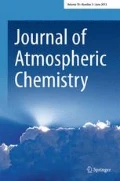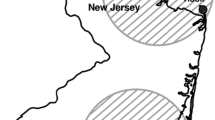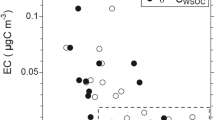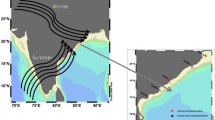Abstract
Sea salt aerosol may be an important sink for reactive gaseous mercury (RGM) in the marine boundary layer, reducing ambient RGM concentrations and transferring the mercury (Hg) to the oceans and coastal ecosystems. The goal of this study was to determine the affinity of gaseous mercury for sea salt aerosol (SSA) by conducting adsorption experiments with sea salt-coated sampling denuders. In the first set of experiments, ambient outdoor air was passed through denuders coated with either KCl, as in the widely accepted method to sample RGM, or with NaCl, a primary component of sea salt aerosols. On the one sampling day in which RGM was above the MDL, the NaCl coated denuders removed Hg from the ambient air, equivalent to 87% of the RGM in the air (as determined by KCl denuders). For the second set of experiments HgCl2 generated in the laboratory was passed through denuders coated with KCl and either NaCl or sea salt. The NaCl denuders collected an average of 99 ± 16% of the mercury that the KCl denuders collected. Newly coated sea salt denuders collected 88 ± 17% of the amount of mercury that the KCl denuders collected, but interestingly the sea salt denuders capacity decreased with repeated use. These experiments demonstrate that HgCl2, a major component of RGM has a strong affinity for NaCl and sea salt and is therefore likely to be scavenged by SSA. This study adds to the growing evidence that RGM is scavenged by sea salt aerosols and therefore more quickly deposited to the ocean and coastal environment.





Similar content being viewed by others
References
Appel, B.R.: Sampling of selected labile atmospheric pollutants. In: Newman, L. (ed.) Measurement Challenges in Atmospheric Chemistry, pp. 1-40. American Chemical Society, Washington (1993)
Burkhardt, J., Eiden, R.: Thin water films on coniferous needles. Atmos Environ 28, 2001–2011 (1994)
CRC Handbook of Chemistry and Physics, 82nd ed. CRC Press, Boca Raton, FL (2009)
Dumarey, R., Temmerman, E., Dams, R., Hoste, J.: The accuracy of the vapour-injection calibration method for the determination of mercury by amalgamation/cold vapour atomic absorption spectrometry. Anal Chim Acta 170, 337–340 (1985)
Engle, M.A., Tate, M.T., Krabbenhoft, D.P., Kolker, A., Olson, M.L., Edgerton, E.S., DeWild, J.F., McPherson, A.K.: Characterization and cycling of atmospheric mercury along the central US Gulf Coast. Appl Geochem 23, 419–437 (2008)
Gustafsson, M.E.R., Franzen, L.G.: Inland transport of marine aerosols in southern Sweden. Atmos Environ 34, 313–325 (2000)
Hedgecock, I.M., Pirrone, N.: Mercury and photochemistry in the marine boundary layer—Modeling studies suggest the in situ production of reactive gas phase mercury. Atmos Environ 35, 3055–3062 (2001)
Holmes, C.D., Jacob, D.J., Mason, R.P.: Sources and deposition of reactive gaseous mercury in the marine atmosphere. Atmos Environ 43, 2278–2285 (2009)
Kraepiel, A.M.L., Keller, K., Chin, H.B., Malcolm, E.G., Morel, F.M.M.: Sources and variations of mercury in tuna. Environ Sci, Technol 37, 5551–5558 (2003)
Lamborg, C.H., Fitzgerald, W.F., O’Donnell, J., Torgersen, T.: A non-steady-state compartmental model of global-scale mercury biogeochemistry with interhemispheric atmospheric gradients. Geochimica Et Cosmochimica Acta 66, 1105–118 (2002)
Landis, M.S., Stevens, R.K., Schadelick, F., Prestbo, E.M.: Development and characterization of an annular denuder methodology for the measurement of ambient (divalent) inorganic reactive gaseous mercury in ambient air. Environ Sci Technol 36, 3000–3009 (2002)
Lewis, E.R., Schwartz, S.E..: Sea Salt Aerosol Production: Mechanisms, Methods, Measurements, and Models. American Geophysical Union, Washington, D.C. (2004)
Lin, C.J., Pehkonen, S.O.: The chemistry of atmospheric mercury: a review. Atmos Environ 33, 2067–2079 (1999)
Lynam, M.M., Keeler, G.J.: Comparison of methods for particulate phase mercury analysis: sampling and analysis. Anal Bioanal Chem 374, 1009–1014 (2002)
Lynam, M.M., Keeler, G.J.: Artifacts associated with measurement of particulate mercury in an urban environment: the influence of elevated ozone concentrations. Atmos Environ 39, 3081–3088 (2005)
Malcolm, E.G., Keeler, G.J.: Measurements of mercury in dew: atmospheric removal of mercury species to a water surface. Environ Sci Technol 36, 2815–2821 (2002)
Malcolm, E.G., Keeler, G.J.: Evidence for a sampling artifact for particulate-phase mercury in the marine atmosphere. Atmos Environ 41, 3352–3359 (2007)
Malcolm E.G., Keeler G.J., Landis M.S.: The effects of the coastal environment on the atmospheric mercury cycle. J. Geophys. Res. 108 (D12), art. no. 4357, (2003) doi:10.1029/2002JD003084
Patterson, E.M., Kiang, C.S., Delaney, A.C., Wartberg, A.F., Leslie, A.C.D., Huebert, B.J.: Global measurements of aerosols in remote continental and marine regions: concentrations, size distributions, and optical properties. J Geophys Res 85, 7361–7376 (1980)
Pirrone, N., Hedgecock, I.M., Forlano, L.: Role of the ambient aerosol in the atmospheric processing semivolatile contaminants: A parameterized numerical model (Gas-Particle Partitioning (GASPAR)). J Geophys Res-Atmospheres 105(D8), 9773–9790 (2000)
Rutter, A.P., Schauer, J.J.: The impact of aerosol composition on the particle gas partitioning of reactive mercury. Environ Sci Technol 41, 3934–3939 (2007)
Sander, R., Crutzen, P.: Model study indicating halogen activation and ozone destruction in polluted air masses transported to the sea. J Geophys Res 101, 9121–9138 (1996)
Schroeder, W.H., Munthe, J.: Atmospheric mercury—an overview. Atmos Environ 32, 809–822 (1998)
Seigneur, C., Lohman, K.: Effect of bromine chemistry on the atmospheric mercury cycle. J Geophys Res 113, D23309 (2008). doi:10.1029/2008JD010262
Selin, N.E.: Global biogeochemical cycling of mercury: a review. Annu Rev Environ Resource 34, 43–63 (2009)
Selin, N.E., Jacob, D.J.: Seasonal and spatial patterns of mercury wet deposition in the United States: Constraints on the contribution from North American anthropogenic sources. Atmos Environ 42(21), 5193–5204 (2008)
Selin, N.E., Jacob, D.J., Park, R.J., Yantosca, R.M., Strode, S., Jaeglé, L., Jaffe, D.: Chemical cycling and deposition of atmospheric mercury: global constraints from observations. J Geophys Res 112, D02308 (2007). doi:10.1029/2006JD007450
Sprovieri, F., Pirrone, N.: Spatial and temporal distribution of atmospheric mercury species over the Adriatic Sea. Environ Fluid Mech 8, 117–128 (2008)
Sunderland, E.M., Krabbenhoft, D.P., Moreau J.W.: Mercury sources, distribution, and bioavailability in the North Pacific Ocean: Insights from data and models. Global Biogeochem. Cycl. 23, art no. GB2010 (2009)
Trujillo, A.P., Thurman, H.V.: Essentials of Oceanography, 9th edn. Pearson Prentice Hall, Upper Saddle River (2008)
Acknowledgements
Funding was gratefully supplied by the Jeffress Memorial Trust and Virginia Wesleyan College. We thank Dr. Thomas Atkinson and the Florida Department of Environmental Protection for the loan of the sampling manifold and Dr. Gerald Keeler at the University of Michigan Air Quality Laboratory for additional equipment. We are grateful to Dr. Margaret Reese of Virginia Wesleyan College and Dr. Terry Glover of Bloomfield College for statistical assistance and Dr. Mary Lynam of Marygrove College for advice on methods. We thank the many students at Virginia Wesleyan College who have assisted with this research, especially Ivy Ozmon and A.J. Ward. We appreciate the advice of two anonymous reviewers for suggestions that improved the manuscript.
Author information
Authors and Affiliations
Corresponding author
Rights and permissions
About this article
Cite this article
Malcolm, E.G., Ford, A.C., Redding, T.A. et al. Experimental investigation of the scavenging of gaseous mercury by sea salt aerosol. J Atmos Chem 63, 221–234 (2009). https://doi.org/10.1007/s10874-010-9165-y
Received:
Accepted:
Published:
Issue Date:
DOI: https://doi.org/10.1007/s10874-010-9165-y




